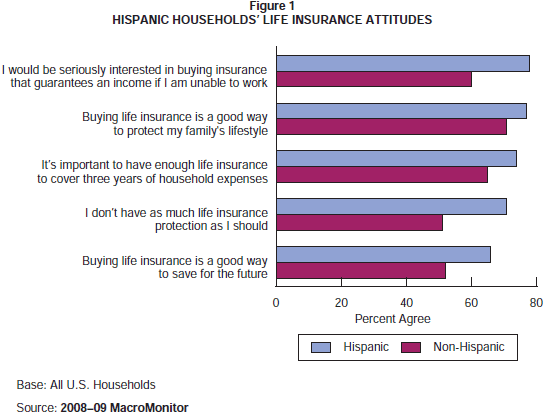MacroMonitor Market Trends September 2010
MacroMonitor Market Trends is a newsletter from Consumer Financial Decisions that highlights topical news and trends of interest to you and your colleagues. If you would like more information about the items in the newsletter or would like to discuss other ways that we can assist you in your research and marketing efforts, please contact us.
In this issue:
Opportunity: Hispanic Households and Life Insurance
More than two in five Hispanic households (42%) do not have life insurance—an incidence that is 45% higher than that for non-Hispanic households. (Hispanic households are financially acculturated households—those that can read and write in English and have the financial sophistication to complete the MacroMonitor survey—with a primary head who is of a Hispanic ethnic background.) Interestingly, however, attitudinal data indicate that Hispanic households have, in general, more favorable attitudes toward life insurance than their non-Hispanic counterparts have. As Figure 1 indicates:
- Hispanic households are significantly more likely than non-Hispanic households to agree that buying life insurance is a good way to save for the future: 66% and 52%, respectively.
- Three-quarters of Hispanic households agree that it is important to have enough life insurance to cover three years of expenses; fewer than two-thirds of non-Hispanic households agree.
- About eight in ten Hispanic households (78%) would be seriously interested in buying insurance that guarantees an income if they were unable to work—an incidence that is significantly greater than that for non-Hispanics (60%).
- In comparison with just about half of non-Hispanic households (51%), more than seven in ten Hispanic households (71%) admit that they don't have as much life insurance protection as they should have.

Hispanic households are significantly more likely to report that they plan to buy individual life insurance for the first time in the next 12 months: 18%, in comparison with 10% of non-Hispanic households. This finding, in combination with their favorable attitudes toward life insurance, indicates an opportunity for financial-services providers selling life insurance to Hispanic households. Interestingly, Hispanic households have distinct and different preferences about buying life insurance. These preferences are important for financial providers to consider. Hispanic households are significantly more likely than non-Hispanic households to agree that they prefer to deal with an agent face-to-face when buying life insurance (92% and 85%, respectively). Hispanic households are also more likely to report that they would like to obtain life insurance in a convenient way. For example, Hispanic households are more likely to agree that they would rather buy their life insurance from a bank, S&L, or credit union than from an insurance company (25%, in comparison with 14% for non-Hispanic households) as well as buy life insurance at work through payroll deductions (52% and 37%, respectively). Thus, financial providers attempting to capitalize on the opportunity to sell life insurance to Hispanic households should keep in mind those households' preference for personal interaction and convenience.
Exclusive Report: Boomers Near Retirement
A recent report produced by CFD in collaboration with the Insured Retirement Institute (IRI) found that unretired Boomer households that are more than five years out from retiring consider "living within a fixed income" to be their top retirement focus. And they want to receive their advisors' advice face-to-face, not electronically, the report shows.
Among this group, the overall attitude about retirement preparedness is pessimistic, with six out of ten expressing concern about outliving their savings and investments and seven out of ten "afraid" that their household is not saving enough to cover future needs. In addition, nearly half of all surveyed unretired Boomers stated that they would put most of their assets in an investment that provides guaranteed income for life, even if it pays a low return.
Because just slightly more than one-third of Boomers within five years of retirement have a fully vested pension, and given the uncertain status of Social Security, unretired Boomers are understandably concerned about having sufficient income in retirement. Nearly 7 out of 10 Boomers within five years of retirement and nearly 8 out of 10 of Boomers outside that window stated that they are concerned about having adequate income during retirement.
"The need to solve the retirement income crisis has reached a critical point, as unretired Boomers look to their future with great uncertainty on how to make ends meet during their retirement," IRI president and CEO Cathy Weatherford said. "Despite its perilous state, our survey found that more than half of all unretired Boomers plan to rely on Social Security for their retirement income. This is a clear indication that financial professionals, elected officials and the media all need to better educate consumers to look outside of Social Security to meet their guaranteed retirement income needs."
Among the key findings:
- Almost eight in ten Boomers within five years of retirement state that they will try to live on income alone (Social Security, pensions, interest, and so on).
- For Boomers more than five years out from retiring, more than half—55%—do not know how much they need to save for retirement.
- Approximately six out of ten Boomers within five years of retirement prefer to consult a specialist when making financial decisions.
- Unretired Boomers cite retirement planning as the top financial advice that they would like to receive in the next 12 months, expressing a clear preference for gaining that information in a face-to-face exchange, rather than via online and electronic methods.
For more information about this report, please visit IRI's website.